| After missing the NAMM show last year - for the first time since 1976 - it was good to be back. This year, they moved the security perimeter outside the buildings so people did not have be searched when they went from one area to another. Since this is a huge event, anything they can do to streamline the lines is much appreciated. By the way, I missed the 2018 show because my wife and I were on a cruise through the Panama Canal - not because I was banned in any way! |
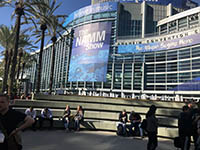 |
| NAMM has always had humorous security signs. For example, "hoverboards" have been banned for several years. This year they added "masks and/or face coverings." I am not sure if this was a serious item or not ... |
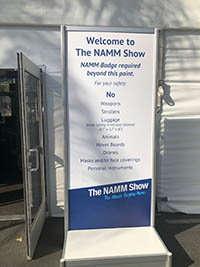 |
| As if things weren't already big enough, the Anaheim Convention Center opened a new wing last year. This was my first time in this wing since I missed the 2018 show. NAMM moved most of the pro audio exhibits here. |
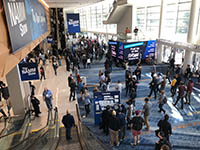 |
| The big new thing at NAMM 2019 appeared to be things that light up in various colors in response to music. Of course, people my age were introduced to this concept in the 1960s with the "color organ." Color organs were devices - mostly home-built - that had a simply circuit that measured audio levels and drove a set of incandescent light bulbs that were mounted behind prismatic plastic sheets. Other people may have seen such devices in old movies from he 60s. In any event, with he advent of inexpensive colored LED lighting strips and almost-free microprocessors, these things are back! There were tons of products that light up in various ways. Here is a plastic ukulele that lists up n various colors as you play it. |
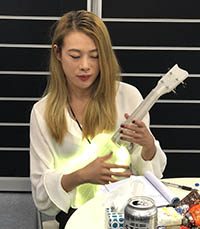 |
| Here are some speaker cabinets that light up when sound is played through them. These are from Ningbo Xien Electronics. |
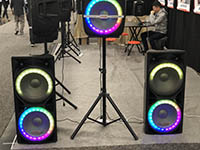 |
| And here is a guitar strap that lights up when you play your guitar. In this way you don;t have to buy a new light-up guitar to get this effect! The strap is even patented! |
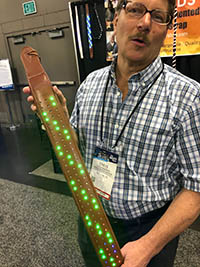 |
| As an organist, I am always looking for organ-related innovations. Here is a company that sells "pedalboards." Unfortunately for me, these are not for organs but rather for guitar players. This is not the first time I have been mislead by such a product name. These are frames for holding arrays of guitar effect pedals. These particular ones are made by Temple Audio Design and allow you to attach a wide variety of effects pedals without resorting to double stick tape or Velcro. I actually build a similar device of my own in the 1970s using plywood and Masonite - for use with my own stack of electric pianos and analog synthesizers. |
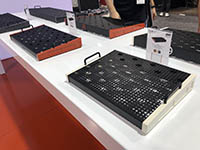 |
| As for the effect pedals themselves, I was most impressed with the products from Jam Pedals. Each is a work of sculpture art in its own right. This example seams to have been inspired by the work of artist/architect Antoni Gaudi. |
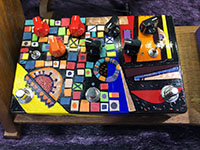 |
| Here is the "O Guitar" from Elroy. I asked the designer if he was trying to attract people to their guitars by making them look more like banjos! This would be a dubious strategy at best. However, that was not their intent. This is one of a set of novel and distinctive guitar designs. |
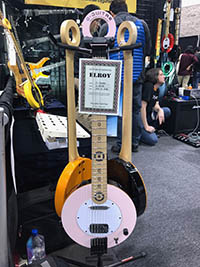 |
| Speaking of banjos, this year seams to also be the year of the re-emergence of the banjo ukulele (or banjo lele) as a popular instrument. These colorful inexpensive examples are from Gold Tone, which also makes very fine ones like the one I own. |
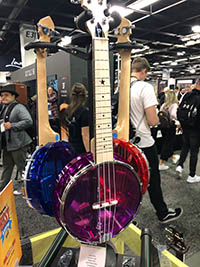 |
| The woman who owns this company is a guitar player whose hands have been riddled with arthritis to the extent that she can no longer bend either of outer joints on any of her fingers. The booth actually featured a huge x-ray image of one of her hands! Rather than give up playing, she invented this interesting device. It is sort of a hand-held capo that she can place against the stings to form a chord. By rotating the device a bit, she can play second chord. In this way, she can play all major and minor chords - albeit in only a single inversion. By using some special string tunings, she can also play diminished chords. A second little device strapped to her little finger allows her to add 6ths and 7ths. The system is called the Rock-It Barre. |
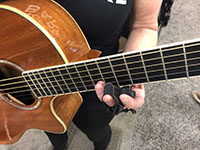 |
| This one is in the category of devices that I do not understand. This is is the Stone Tone Rock Block. It is a small slab of granite that attaches to guitar pickups The inventor claims that "delivers maximum sonic transference." Since I am not a guitarist, I could not really try this out to see if I could tell the difference between regular metal blocks and this stone one. In any case, it looks very cool! |
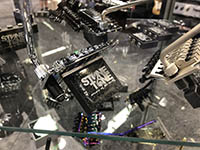 |
| These are Shnobel Tone amplifiers. I have no idea what they sound like - but they look like something that would appear in a 1970s cartoon! Yes, they really are this shape and I did not use Photoshop's distortion utilities. |
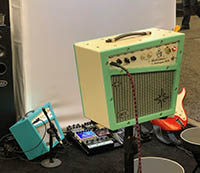 |
| Here is a pocket trumpet - with a Dizzy Gillespie style bell. When Dizzy was alive, many companies copied his trademarked trumpet bell, bent upward so that it would face the audience when the pl,ayer was actually pointing the horn toward the floor. This is the first time I have seen it done with a pocket trumpet. This trumpet, from Carol Brass, also features a larger-than-normal bell diameter. It is very easy to play and has a great sound. |
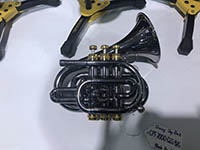 |
| The latest thing from NUVO - which makes plastic musical instruments for very young players - is this plastic French horn. Though it looks like it has piston valves, the actual valves are rotary, as you would expect in a French horn. The pistons connect to a linkage to turn the internal rotary valves. Here I am trying out the horn. |
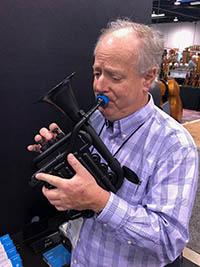 |
| Here is the Win-D-Fender, a clever little plastic baffle that attaches to a flute and allows you to play in high winds. It is designed to allow musicians to play outdoors in adverse condicit0ons, but it also acts as a great noise reduction device for recording flutes in studios. The company had a large fan set up to generate high winds at the show. I tried it myself and it really works. |
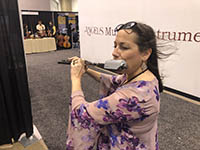 |
| There cases from Jupiter can be customized by the owner using a set of stickers that Jupiter sells separately. I assume one could also print their own stickers for a truly individual case design. No longer will all cases look the same! |
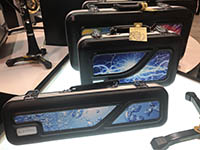 |
| This player piano from Seiler was a big hit at the show because it was so cute! |
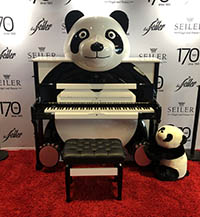 |
| This interesting device is from Piano de Voyage. It is exactly what its company name implies (in French): a travel piano. Unlike those roll-up flexible piano keyboards (and there are still plenty of those at NAMM) this one has physical keys that move. It comes in two-octave modules than can be assembled into any length. When I suggested to the designer that one could create a ten-octave piano, he claimed not to have though of that application. Of course there as still limitations. The piano is does not have a weighted action, and the fulcrum for the keys is necessarily too close to the performer. However, it works a lot better than the flexible ones and can be assembled into arbitrarily large versions. |
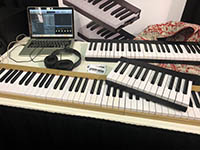 |
| Haken Audio has had a portamento keyboard on the market for a while,. This is a continuous controller that allows you to play any frequency -0 not just the standard musical scale - by sliding your finger along a felt pad. This year, they introduced a small version that is a lot less expensive. Here I am playing it - but it is only the red device at the bottom of the screen. The wooden thing is a hollow soundboard built by La Voix du Luthier. Basically, the sound generated by the Haken controller is played inside the soundboard and picked up by a microphone, also inside the soundboard. This generates an interesting resonance effect. |
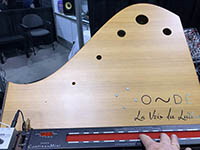 |
| This interesting device was being sold at the Suzuki booth, which was shared with Hammond Organs. It is a Taisho Harp. You finger notes from the plastic tabs and bow the strings that sit underneath. I tried this - but my bowing technique can use some improvement. A real violinist who was also trying out the device told me that it is great but there is no way to get vibrato. |
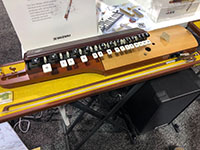 |
| My son, Elliot, is demonstrating another product by Suzuki: hand chimes. These are designed to be used as an alternative to bells in hand bell choirs. Each one has a single celesta-like metal bar and a clapper than is activate when you swing the chime. Unlike hand bells, an entire set of these can be carried in a single case. They also cost a lot less than a set of hand bells! |
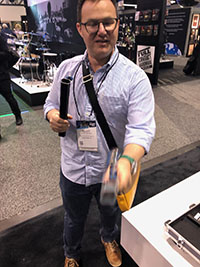 |
| This display outside the Pearl booth is yet another silly overstuffed set of drums. I think this one is actually playable, though I did not try. |
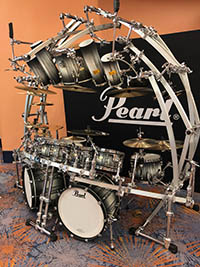 |
| Now here are some drums to which I can relate. This inflatable drum set is from Dorier. It is designed for very young drummers! It really plays - thanks to the fact that is is actually a set of electronic drums. |
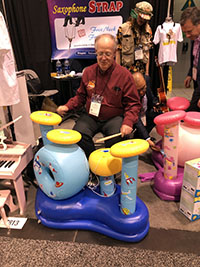 |
| Here is another product in the Suzuki booth - a set of drum pads that you lie on the floor and then walk on. Each produces a different musical note. The possibilities are endless. |
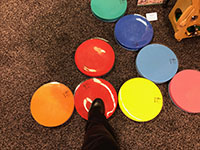 |
| In the category of silly things one might do with musical things. The Novation Launchpad is a 100-button array of color-changing tabs that generates custom midi signals to run lots of devices and software. These versatile midi controllers are being used to create games by many people. You can see this online. Novation itself carried this to the extreme at the 2019 NAMM show with several devices including this dance game. Don't worry, there is a heavy plastic sheet protecting the Launchpad buttons from the dancer's feet! They also had a Pong table built of Launchpads at this booth. |
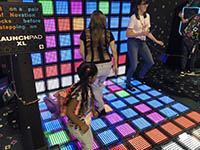 |
| In the category of cure things, here is an array of metronomes in various shapes including the adorable penguin on the end. |
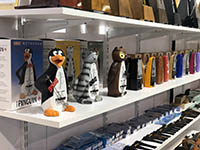 |
| Algorithms AI appears to be a company that writes software to compose music using artificial intelligence. The owner was not around when my son and I passed by. However, I was taken by the simplistic way this booth was assembled. There were no glitzy light arrays, no funny sounds, and no eye-catching signs. It reminded me of a science fair exhibit, so I asked Elliot to pose as if he were explaining such a project. This was rather refreshing! |
 |